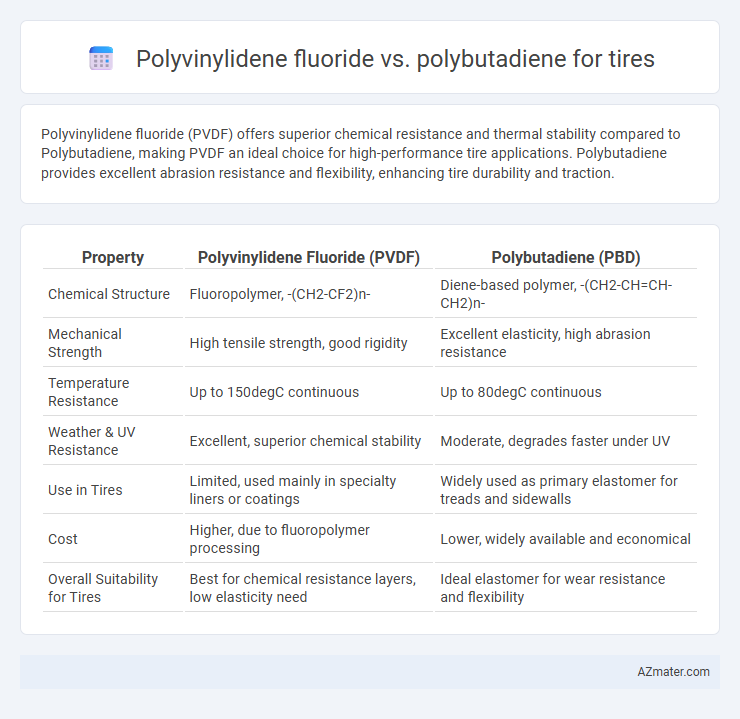Polyvinylidene fluoride (PVDF) offers superior chemical resistance and thermal stability compared to Polybutadiene, making PVDF an ideal choice for high-performance tire applications. Polybutadiene provides excellent abrasion resistance and flexibility, enhancing tire durability and traction.
Table of Comparison
| Property | Polyvinylidene Fluoride (PVDF) | Polybutadiene (PBD) |
|---|---|---|
| Chemical Structure | Fluoropolymer, -(CH2-CF2)n- | Diene-based polymer, -(CH2-CH=CH-CH2)n- |
| Mechanical Strength | High tensile strength, good rigidity | Excellent elasticity, high abrasion resistance |
| Temperature Resistance | Up to 150degC continuous | Up to 80degC continuous |
| Weather & UV Resistance | Excellent, superior chemical stability | Moderate, degrades faster under UV |
| Use in Tires | Limited, used mainly in specialty liners or coatings | Widely used as primary elastomer for treads and sidewalls |
| Cost | Higher, due to fluoropolymer processing | Lower, widely available and economical |
| Overall Suitability for Tires | Best for chemical resistance layers, low elasticity need | Ideal elastomer for wear resistance and flexibility |
Introduction to Polyvinylidene Fluoride and Polybutadiene
Polyvinylidene fluoride (PVDF) is a high-performance fluoropolymer known for its excellent chemical resistance, thermal stability, and mechanical strength, making it suitable for specialty tire components requiring durability and resistance to harsh environments. Polybutadiene is a synthetic rubber with exceptional elasticity, low rolling resistance, and high wear resistance, widely used as a primary material in tire manufacturing to improve traction and extend tire life. Comparing PVDF and polybutadiene highlights differences in their polymer structures and performance characteristics, influencing their specific applications in tire technology.
Chemical Structure Comparison
Polyvinylidene fluoride (PVDF) is a fluoropolymer characterized by a repeating -CH2-CF2- unit, offering exceptional chemical resistance and thermal stability due to strong carbon-fluorine bonds. In contrast, polybutadiene is a diene polymer composed of 1,3-butadiene monomers with repeating -CH2-CH=CH-CH2- units, providing high elasticity and abrasion resistance. These structural differences significantly influence tire performance, with PVDF contributing to enhanced durability and chemical resistance, while polybutadiene imparts flexibility and impact resilience.
Mechanical Properties: Strength and Flexibility
Polyvinylidene fluoride (PVDF) offers superior chemical resistance and excellent tensile strength, making it durable under mechanical stress in tire applications. Polybutadiene excels in flexibility and resilience due to its high elongation at break and low glass transition temperature, providing enhanced impact resistance and fatigue life. The combination of PVDF's strength and Polybutadiene's flexibility influences the overall performance, balancing durability with elasticity in tire manufacturing.
Durability and Wear Resistance
Polyvinylidene fluoride (PVDF) offers superior chemical resistance and UV stability, enhancing its durability in harsh tire environments compared to Polybutadiene. Polybutadiene excels in abrasion resistance and flexibility, contributing to excellent wear resistance under dynamic road conditions. The choice between PVDF and Polybutadiene in tire applications depends on specific performance requirements, with PVDF favored for long-term durability and Polybutadiene for enhanced tread wear and impact absorption.
Performance in Tire Applications
Polyvinylidene fluoride (PVDF) offers superior chemical resistance, thermal stability, and excellent weatherability, making it ideal for high-performance tire applications demanding durability under harsh conditions. Polybutadiene exhibits exceptional elasticity and wear resistance, enhancing tire traction and fuel efficiency through improved rolling resistance and durability. In tire manufacturing, PVDF is preferred for protective coatings and components exposed to chemicals, while polybutadiene is favored in tread compounds for its outstanding mechanical performance and wear characteristics.
Temperature Stability and Environmental Resistance
Polyvinylidene fluoride (PVDF) exhibits superior temperature stability compared to polybutadiene, maintaining structural integrity at temperatures up to 150degC, whereas polybutadiene tends to degrade above 80degC. PVDF offers excellent resistance to UV radiation, chemicals, and oxidation, making it more durable in harsh environmental conditions than polybutadiene, which is prone to ozone cracking and oxidative degradation. These properties make PVDF a more reliable choice for tire applications requiring enhanced longevity and performance under extreme temperature and environmental stress.
Cost-Effectiveness for Tire Manufacturing
Polyvinylidene fluoride (PVDF) offers superior chemical resistance and durability but comes at a higher material cost compared to polybutadiene, which is favored for its excellent elasticity and lower price. Polybutadiene's cost-effectiveness in tire manufacturing is driven by its ability to improve wear resistance and fuel efficiency without significantly increasing production expenses. The balance between PVDF's performance benefits and polybutadiene's affordability makes polybutadiene the preferred choice for most cost-sensitive tire applications.
Sustainability and Environmental Impact
Polyvinylidene fluoride (PVDF) offers superior chemical resistance and durability, contributing to longer tire life and reduced waste compared to Polybutadiene (PBD), which is derived from petroleum and has higher environmental toxicity during production. PVDF's recyclability and lower emissions during manufacturing enhance its sustainability profile, making it a preferable choice for eco-friendly tire applications. Conversely, Polybutadiene's reliance on non-renewable resources and challenges in biodegradability pose greater environmental concerns in tire production and disposal.
Industry Adoption and Current Trends
Polyvinylidene fluoride (PVDF) is gaining traction in the tire industry due to its excellent chemical resistance, high thermal stability, and superior durability, making it ideal for high-performance and specialty tires. Polybutadiene remains widely adopted for its exceptional elasticity and wear resistance, crucial for standard passenger and commercial tires, with global manufacturers emphasizing improved formulations to enhance rolling resistance and wet traction. Current trends highlight increasing use of PVDF in niche applications such as electric vehicle tires where heat management and longevity are critical, while polybutadiene continues to dominate mass production driven by cost-effectiveness and established performance metrics.
Conclusion: Choosing the Right Polymer for Tires
Polyvinylidene fluoride (PVDF) offers excellent chemical resistance, weatherability, and mechanical strength, making it ideal for tire components exposed to harsh environmental conditions. Polybutadiene provides superior elasticity and low-temperature flexibility, enhancing tire traction and wear resistance for improved performance. Selecting the right polymer depends on the specific tire application demands, where PVDF suits durability-focused parts and polybutadiene excels in dynamic, flexible areas.

Infographic: Polyvinylidene fluoride vs Polybutadiene for Tire
 azmater.com
azmater.com